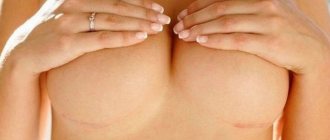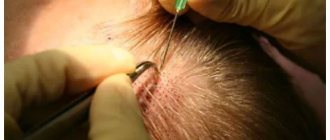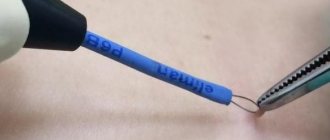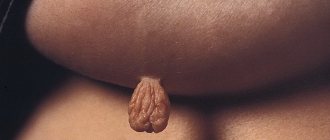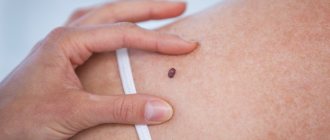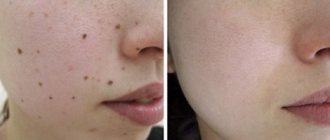- Wart removal
- Diagnosis of neoplasms
- Removal of condylomas
Plantar warts look like round or oval skin lesions with a diameter of no more than 1 - 2 cm. In most cases, they are not distinguished by color, but may have a pink or brownish color. Over time, the protrusion becomes rough and rough to the touch due to constant friction.
Treatment methods
Depending on the severity of the problem and individual contraindications, plantar tumors are removed in different ways:
- electrocoagulation with high-frequency current;
- cryodestruction with liquid nitrogen;
- surgery;
- conservative drug therapy;
- radio wave exposure;
- laser technique.
Laser removal is recognized as the most effective and safe in modern medicine. Light radiation burns damaged tissue without injuring nearby ones. At the same time, neighboring cells are “sterilized,” which eliminates the risk of re-formation of plantar warts. The non-invasive, non-contact method eliminates the possibility of infection, does not cause discomfort, and has a short rehabilitation period. Another advantage of the laser is a reduced list of contraindications. The technique is also used in patients with insufficient blood clotting, a tendency to allergies, weakened immunity, and impaired metabolism.
Laser removal of warts on the elbow. Wart removal in progress. No traces remain
Laser removal of warts on the finger. Removing warts on hands with laser. Fast and painless.
Laser removal of multiple warts on the hand. Laser removal of warts
Modern method of wart removal
The prerequisite for the appearance of warts is reduced human immunity. The growths grow quickly and can form entire clusters. You can become infected with the papilloma virus, the root cause of the disease, through contact with a sick person or through his personal belongings. Whatever the reason for the appearance of warts, they must be dealt with. The first stage of complex treatment is the removal of all formations on the skin.
Content:
- Modern method of wart removal
- What warts can be removed with laser?
- Benefits of the procedure
- Contraindications for this procedure
- How is the procedure performed?
- Rehabilitation after laser removal
- Home care
Modern methods of excision of warts include radio wave and laser removal. Destruction of skin tumors using a laser is the simplest and most painless procedure that guarantees a stable result. A mini-operation is performed using local anesthesia and without additional lengthy preparation. Delicate removal of the growth is carried out in a specialized office and only by an experienced doctor. The stages of the procedure and the qualifications of the doctor guarantee that there will be no relapse of the disease in the near future.
In what cases is tumor removal prescribed?
Experts recommend seeking help if there are indications:
- pain when wearing tight shoes or walking for a long time;
- bleeding in the affected area;
- uneven coloring of the neoplasm;
- rapid growth, association of individual lesions into masses.
If you still have doubts about whether it is worth removing the tumors, seek the advice of a specialist.
How is the procedure performed?
The procedure is carried out under sterile conditions. The patient first undergoes blood and urine tests. Based on the results obtained, the type of anesthesia used and painkillers that will be needed during laser therapy are determined. The non-invasive method eliminates any contact with the skin: the person sits on a comfortable couch in a lying or sitting position. A drug is injected on the sides of the wart, which should reduce any pain.
After 5-10 minutes, the injected drug begins to act. The laser beam acts on the growth within a few minutes. After the procedure, the affected area of skin is treated with special products and a bandage is applied.
The half-hour operation does not require hospitalization of the patient: immediately after laser therapy, the patient goes home on his own.
Skin treatment and re-dressings are carried out at home. During the procedure, the likelihood of bleeding is completely eliminated. If there is no cut on the skin, infections or pathogenic microorganisms cannot enter the wound - secondary postoperative infection is excluded.
Contraindications to laser treatment
- infections and exacerbation of chronic pathologies;
- diabetes mellitus in the stage of decompensation;
- epilepsy and mental disorders;
- history of oncological pathologies;
- pregnancy and lactation;
- exacerbation of herpes.
| Cost of removing plantar warts | |
| Plantar warts up to 5 mm | 2950 rub. |
| Plantar warts from 5 to 10 mm | 3750 rub. |
| Plantar wart from 10 mm to 3 cm | 4900 rub. |
Sign up for a consultation
Contraindications for this procedure
This effective technique has a number of contraindications. In preparation for the mini-surgery, the patient undergoes a complete examination of the body. Based on the results obtained, the attending physician evaluates further treatment methods and risks for the patient. Contraindications to laser therapy:
- skin rash and herpes;
- advanced dermatitis;
- high blood pressure;
- acute respiratory diseases (the patient has a weakened immune system after illnesses);
- malignant diseases.
A pregnant woman should refuse the procedure: if possible, laser therapy is postponed until the postpartum period. If a rash of unknown origin appears on a person’s body, it is necessary to wait a little while removing the warts. Systemic diseases are direct contraindications to mini-surgery.
Diseases of the thyroid gland exclude the use of a laser beam to remove an unpleasant wart. Sun allergy is a rare disease that does not allow a laser procedure: in such cases, warts are combated using radio wave therapy. Severe renal and liver failure is a contraindication to mini-surgery. Before using the modern technique, it is necessary to take into account all contraindications that can cause serious complications in an adult or child.
Preparation and carrying out the procedure
The appointment of a session is preceded by a consultation with a specialist. The doctor examines the tumors, selects the necessary laser parameters, and collects anamnesis to eliminate the risk of contraindications. If necessary, additional laboratory and instrumental studies are prescribed.
Before the procedure, the target area is decontaminated and treated with a local anesthetic. In combination with the laser cooling system, it provides complete patient comfort. Using the device's manipulator, the doctor acts on the affected skin in a targeted manner. High temperature burns damaged cells at a given depth, disinfects the wound surface and coagulates blood vessels. The whole procedure takes only a few minutes.
To completely remove a plantar wart, one session of laser treatment is usually sufficient. After treatment, the affected epidermis becomes covered with brown granulations, which disappear over time and leave clean, young skin.
What warts can be removed with laser?
Papillomas can differ in appearance and location on the human body. Warts affect the arms, legs, back and face of both adults and children. There are no age restrictions for patients suffering from papillomatosis. Laser therapy can remove plantar warts. These are neoplasms on the foot that develop in the horny part of the skin. By layering, the dead skin turns into a compaction with a visible, clear core in the center.
Using a laser, ordinary warts are removed: growths of a dense, rounded structure. Such warts differ from the color of the skin (they are much darker). Over time, common warts increase in size and annoy a person: they bring severe discomfort and periodically hurt.
Laser therapy is used to remove flat warts. The size of small formations is no more than 1 cm. The growths have a flat structure and from the outside resemble skin-colored nodular formations. Flat warts do not rise much above the skin and rarely cause discomfort in humans. Before prescribing a laser technique to remove the growth, an accurate diagnosis is determined - the wart and its type are examined.
Photos of completed work
Rehabilitation after laser removal
The healing of the skin area affected by the wart directly depends on the procedure performed. The high-tech laser is completely sterile (bactericidal). It acts on the skin and does not cause inflammation - for this reason, there are no scars or noticeable scars left on the body. The causative agent of bacteria or viruses is completely destroyed in the laser-treated area. Immediately after the procedure, slight discomfort may be felt under the bandage, which soon goes away.
The skin is completely restored within 2 weeks (up to a month in people with weakened immune systems). A hard crust forms on the treated area: healing occurs underneath it. Once the underlying skin has healed, the scab will fall off without further damage.
The crust lasts for about 10 days and does not cause any discomfort in humans. New skin appears in the third week after the procedure.
Best materials of the month
- Coronaviruses: SARS-CoV-2 (COVID-19)
- Antibiotics for the prevention and treatment of COVID-19: how effective are they?
- The most common "office" diseases
- Does vodka kill coronavirus?
- How to stay alive on our roads?
Features of papillomas
Papillomas can be of the following types: ordinary or vulgar warts, filiform (the most common type), flat, genital warts, plantar warts, juvenile warts. A dermatologist diagnoses and treats papillomas.
Most often, papillomas are localized in the armpits and inguinal folds, hands, on the surface of the foot, neck, under the mammary glands in women, as well as on the genitals. Papillomas located on the mucous membranes of internal organs are very dangerous; they can cause ulceration or bleeding. As a rule, papillomas that have a pronounced cosmetic defect are removed with a laser, i.e. which are located in open areas of the body, as well as those with a high risk of cancer.
Why do you need to remove warts?
Treatment of warts consists of removing them and undergoing antiviral therapy, if necessary. Often, patients try to remove warts on their own, using various home folk remedies (celandine, etc.) - most often this leads to dissemination (reappearance of warts, the appearance of warts in other places, an increase in their number). Warts do not go away on their own; this happens in isolated cases and you should not count on it. Warts are not only an aesthetic problem; sometimes they are accompanied by more serious problems. Periungual warts can lead to detachment or deformation of the nail plate. Plantar warts cause pain while walking. Therefore, warts should be eliminated as soon as they appear to avoid possible consequences. If warts are removed in a timely manner, the procedure will be less painful, faster, cheaper and the healing process will be easier.




